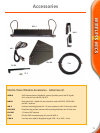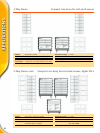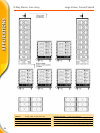
87
Ring Mode Decoupling
®
(RMD
®
)
Electro-Voice pioneered Ring Mode Decoupling (RMD
®
) as a
result of experience gained through years of high-level concert
system design. The acclaimed EV X-Array™ was the “test bed”
for RMD
®
research. Just as automotive companies use Formula 1
racing to develop new technologies, Electro-Voice uses its work in
the concert sound and touring industries to do the same. The goal
of that basic research is to bring those new technologies into all
aspects of the sound reinforcement industry.
All loudspeaker components display unwanted vibrational modes
– or resonances – that produce both frequency and time-domain
distortions. A time-domain distortion is most often described by
loudspeaker users as a “ringing” in the system. This ringing is usu
-
ally most audible through the vocal fundamental range, and users
commonly attempt to “cure” the ringing mode through equaliza-
tion. Unfortunately such attempts remove not only the time-
domain distortion, or ringing, but also parts of the musical signal
as well. The net result is that musical information is lost.
RMD
®
is a series of techniques developed by Electro-Voice engi-
neers to deal with the time-domain distortion at its source.
The basic problem is mechanical in nature. As a result, the only
really effective solution is also mechanical. When acoustic
resonances are encountered, the only effective solution is an
acoustic remedy. The same applies to electrical resonances:
The solution must be electrical.
RMD
®
treatment produces an acoustic signal that is much freer of
mechanical and acoustical ringing modes. The result is a level of
fidelity – particularly through the critical vocal range – that is more
coher
ent and “in your face.” Another benefit of RMD
®
technolo
-
gy is a much higher degree of level independence. Many front-of-
house engineers have noted that system equalization needs to
change with system output levels. The louder the system is driven,
the more EQ changes become necessary to maintain system voic-
ing (that is, the system sounds dif
fer
ent at higher power levels).
RMD
®
gr
eatly minimizes the changes in system voicing that occur
with level changes. Systems with RMD
®
, therefore, display a high
degr
ee of level-independent fidelity and a ver
y audible impr
ove-
ment in vocal clarity as well.
Power handling ratings
Accurately specifying power handling ratings presents a challenge
with odds typically worse than those in a game of chance. Each
manufacturer rates its components in its own particular way.
While responsible manufacturers always qualify their testing
methods, this offers little help to users not familiar with the differ-
ent test methods.
Electro-Voice has used an EIA-based rating for many years. It
offers a reasonably good combination of mechanical (excursion)
and thermal (heat) stress measurements. The ratings supplied
with EV components are very conservative, and require a full
eight-hour test cycle to generate.
However, Electro-Voice does not limit its power testing to EIA
methods. Long term continuous musical testing of rated program
limits is typically performed for 200-hour durations. EV engineers
also perform mixed-signal testing, a combination of continuous
noise (EIA- or AES-based shaped spectrum signals) and low-fre-
quency impulsive signals (such as kick drums). Mixed signal tests
often represent typical program material, and the resulting meas-
urements relate better to real-world conditions.
The most useful power handling rating is that of the program
material specification. This rating relates well to “in the field” sit-
uations for most musical programs. It should always be remem-
bered that no test method or rating spec will universally describe
every situation. Extreme power levels can produce either mechan-
ical or thermal failures with any manufacturer’s components.
Manifold Technology
®
In 1986, Electro-Voice revolutionized concert sound reinforce-
ment by introducing Manifold Technology
®
. In each of the four
bandpasses covering the entire frequency range, the output of
four loudspeakers was flawlessly combined – or “manifolded” –
into a single horn (such as a large-format MH horn) or low-fre-
quency enclosure. The result was a physical package, a fraction of
the size of conventional concert rigs but with four times the
acoustic output. This eliminated the drastically uneven coverage
that occurs when multiple acoustic sources are stacked to gain
more output. Manifold Technology
®
came into its own particular-
ly in smaller-sized locations or installations, where low-frequency
output was limited by the space available.
Speaker Technologies


















